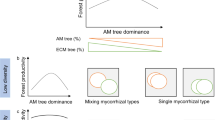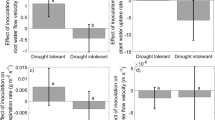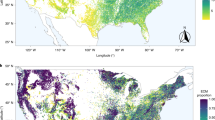Abstract
THE mutualistic ectomycorrhizal fungi associated with the roots of woody perennials can enhance nutrient uptake and provide protection from pathogens in exchange for up to 40% of the photosynthate produced by host plants1–9. By removing photo-synthetic tissue, herbivores could reduce the amount of photosynthate available for maintaining this mutualism10–15, 29. Here we examine how ectomycorrhizal levels vary between trees resistant and susceptible to an insect herbivore, and demonstrate how mycorrhizal levels respond to the experimental removal of a native herbivore under natural conditions. We find that pinyon pine trees susceptible to chronic insect attack have 33% fewer ectomycor-rhizae than resistant trees, demonstrating that the herbivore–mycorrhizae–host plant interaction differs between resistant and susceptible trees. We removed insects from susceptible trees and find that the mycorrhizal levels of these trees increased to a level comparable to that of resistant trees. This demonstrates that herbivores negatively affect the mutualism between ectomycorrhizal fungi and susceptible trees, and that mycorrhizal levels can rebound after herbivore removal. The dynamics of these interactions on resistant and susceptible plants could be important for understanding plant–pest interactions in natural and managed systems.
This is a preview of subscription content, access via your institution
Access options
Subscribe to this journal
Receive 51 print issues and online access
$199.00 per year
only $3.90 per issue
Buy this article
- Purchase on SpringerLink
- Instant access to full article PDF
Prices may be subject to local taxes which are calculated during checkout
Similar content being viewed by others
References
Meyer, F. H. in Ectomycorrhizae: Their Ecology and Physiology (eds Marks, G. C. & Kozlowski, T. T.) 79–105 (Academic, London, 1973).
Marx, D. H. in Ectomycorrhizae: Their Ecology and Physiology (eds Marks, G. C. & Kozlowski, T. T.) 351–381 (Academic, London, 1973).
Bowen, G. D. in Ectomycorrhizae: Their Ecology and Physiology (eds Marks, G. C. & Kozlowski, T. T.) 151–205 (Academic, London, 1973).
Hacskaylo, E. in Ectomycorrhizae: Their Ecology and Physiology (eds Marks, G. C. & Kozlowski, T. T.) 207–230 (Academic, London, 1973).
Reid, C. P. P. in The Rhizosphere (ed. Lynch, J. M.) 281–315 (Wiley: New York, 1990).
Scott, G. D. Plant Symbiosis (St. Martins, New York, 1969).
Dehne, H. W. Phytopathology 70, 293–296 (1982).
Fogel, R. & Hunt, G. Can. J. For. Res. 9, 245–256 (1979).
Harley, J. L. & Smith, S. E. Mycorrhizal Symbosis (Academic, London, 1983).
Bethlenfalvay, G. J. & Dakessian, S. J. Range Mgmt 37, 312–316 (1984).
Bethlenfalvay, G. J., Evans, R. A. & Lesperance, A. L. Agron. J. 77, 233–236 (1985).
Borowicz, V. A. & Fitter, A. H. Oecologia 82, 402–407 (1990).
Daft, M. J. & El-Giahmi, A. A. New Phytol. 80, 365–372 (1978).
Trent, J. D., Wallace, L. L., Svejcar, T. J. & Christiansen, S. Can. J. Plant Sci. 68, 115–120 (1988).
Jones, C. G. & Last, F. T. in Microbial Mediation of Plant-Herbivore Interactions (eds Barbosa, P., Krischik, V. A. & Jones, C. G.) 65–104 (Wiley, New York, 1991).
Whitham, T. G. & Mopper, S. Science 228, 1089–1091 (1985).
Mopper, S., Mitton, J. B., Whitham, T. G., Cobb, N. S. & Christensen, K. M. Evolution 45, 989–999 (1991).
Harvey, A. E., Larsen, M. J. & Jurgensen, M. F. For. Sci. 22, 393–398 (1976).
Wilcox, H. E. in Methods and Principles of Mycorrhizal Research (ed. Schenck, N. C.) 103–114 (American Phytopathological Society, St. Paul, 1982).
Rabin, L. B. & Pacovsky, R. S. J. Econ. Ent. 78, 1358–1363 (1985).
Findlay, R. in Ecological Interactions in Soil: Plants, Microbes and Animals (eds Fitter, A. H., Atkinson, D., Read, D. J. & Usher, M. B.) 319–331 (Blackwell Scientific, Palo Alto, 1985).
McGonigle, T. P., & Fitter, A. H. in Mycorrhizae in the Next Decade: Practical Applications and Research Priorities (eds Sylvia, D. M., Hung, L. L. & Graham, J. H.) 209 (Institute of Food and Agricultural Studies, University of Florida, Gainesville, 1987).
McGonigle, T. P. & Fitter, A. H. Proc. R. Soc. Edinb. B94, 25–32 (1988).
Rabatin, S. C. & Stinner, B. R. in Microbial Mediation of Plant-Herbivore Interactions (eds Barbosa, P., Krischik, V. A. & Jones, C. G.) 141–168 (Wiley, New York, 1991).
Cline, H. L. & Reid, C. P. P. For. Sci. 28, 237–250 (1982).
Last, F. T., Wilson, J. & Mason, P. A. Agric. Ecosyst. Environ. 28, 293–298 (1990).
Zar, J. H. Biostatistical Analysis (Prentice-Hall, Englewood Cliffs, 1984).
Snedecor, G. W. & Cochran, W. G. Statistical Methods (Iowa State University Press, Ames, 1980).
Last, F. T., Pelham, J., Mason, P. A. & Ingleby, R. Nature 280, 168–169 (1979).
Author information
Authors and Affiliations
Rights and permissions
About this article
Cite this article
Gehring, C., Whitham, T. Herbivore-driven mycorrhizal mutualism in insect-susceptible pinyon pine. Nature 353, 556–557 (1991). https://doi.org/10.1038/353556a0
Received:
Accepted:
Issue date:
DOI: https://doi.org/10.1038/353556a0
This article is cited by
-
Benefits of symbiotic ectomycorrhizal fungi to plant water relations depend on plant genotype in pinyon pine
Scientific Reports (2023)
-
Trees and Insects Have Microbiomes: Consequences for Forest Health and Management
Current Forestry Reports (2021)
-
Tree species and soil nutrients drive tropical reforestation more than associations with mycorrhizal fungi
Plant and Soil (2017)
-
Plant species differ in early seedling growth and tissue nutrient responses to arbuscular and ectomycorrhizal fungi
Mycorrhiza (2017)
-
Asymmetric response of root-associated fungal communities of an arbuscular mycorrhizal grass and an ectomycorrhizal tree to their coexistence in primary succession
Mycorrhiza (2017)



